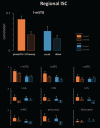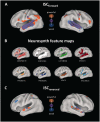Engaged listeners: shared neural processing of powerful political speeches
- PMID: 25653012
- PMCID: PMC4526488
- DOI: 10.1093/scan/nsu168
Engaged listeners: shared neural processing of powerful political speeches
Abstract
Powerful speeches can captivate audiences, whereas weaker speeches fail to engage their listeners. What is happening in the brains of a captivated audience? Here, we assess audience-wide functional brain dynamics during listening to speeches of varying rhetorical quality. The speeches were given by German politicians and evaluated as rhetorically powerful or weak. Listening to each of the speeches induced similar neural response time courses, as measured by inter-subject correlation analysis, in widespread brain regions involved in spoken language processing. Crucially, alignment of the time course across listeners was stronger for rhetorically powerful speeches, especially for bilateral regions of the superior temporal gyri and medial prefrontal cortex. Thus, during powerful speeches, listeners as a group are more coupled to each other, suggesting that powerful speeches are more potent in taking control of the listeners' brain responses. Weaker speeches were processed more heterogeneously, although they still prompted substantially correlated responses. These patterns of coupled neural responses bear resemblance to metaphors of resonance, which are often invoked in discussions of speech impact, and contribute to the literature on auditory attention under natural circumstances. Overall, this approach opens up possibilities for research on the neural mechanisms mediating the reception of entertaining or persuasive messages.
Keywords: fMRI; inter-subject correlation; listening; rhetoric; speech.
© The Author (2015). Published by Oxford University Press. For Permissions, please email: journals.permissions@oup.com.
Figures





Similar articles
-
A naturalistic fMRI dataset in response to public speaking.Sci Data. 2025 Apr 19;12(1):659. doi: 10.1038/s41597-025-05017-5. Sci Data. 2025. PMID: 40253420 Free PMC article.
-
The broadcast of shared attention and its impact on political persuasion.J Pers Soc Psychol. 2016 Nov;111(5):665-673. doi: 10.1037/pspa0000065. Epub 2016 Sep 22. J Pers Soc Psychol. 2016. PMID: 27657306
-
How real-life health messages engage our brains: Shared processing of effective anti-alcohol videos.Soc Cogn Affect Neurosci. 2017 Jul 1;12(7):1188-1196. doi: 10.1093/scan/nsx044. Soc Cogn Affect Neurosci. 2017. PMID: 28402568 Free PMC article.
-
Invited and uninvited applause in political speeches.Br J Soc Psychol. 2006 Sep;45(Pt 3):563-78. doi: 10.1348/014466605X55440. Br J Soc Psychol. 2006. PMID: 16984721 Review.
-
Elevator Speeches (Pitches) and the Pareto Principle.Int J Low Extrem Wounds. 2023 Aug 27:15347346231197499. doi: 10.1177/15347346231197499. Online ahead of print. Int J Low Extrem Wounds. 2023. PMID: 37635317 Review. No abstract available.
Cited by
-
Cortical representation of group social communication in bats.Science. 2021 Oct 22;374(6566):eaba9584. doi: 10.1126/science.aba9584. Epub 2021 Oct 22. Science. 2021. PMID: 34672724 Free PMC article.
-
Hyperscanning shows friends explore and strangers converge in conversation.Nat Commun. 2024 Sep 5;15(1):7781. doi: 10.1038/s41467-024-51990-7. Nat Commun. 2024. PMID: 39237568 Free PMC article.
-
A World Unto Itself: Human Communication as Active Inference.Front Psychol. 2020 Mar 25;11:417. doi: 10.3389/fpsyg.2020.00417. eCollection 2020. Front Psychol. 2020. PMID: 32269536 Free PMC article.
-
Listening in Naturalistic Scenes: What Can Functional Near-Infrared Spectroscopy and Intersubject Correlation Analysis Tell Us About the Underlying Brain Activity?Trends Hear. 2018 Jan-Dec;22:2331216518804116. doi: 10.1177/2331216518804116. Trends Hear. 2018. PMID: 30345888 Free PMC article.
-
Shared understanding of narratives is correlated with shared neural responses.Neuroimage. 2019 Jan 1;184:161-170. doi: 10.1016/j.neuroimage.2018.09.010. Epub 2018 Sep 12. Neuroimage. 2019. PMID: 30217543 Free PMC article.
References
-
- Alho K, Rinne T, Herron T, Woods D. Stimulus-dependent activations and attention-related modulations in the auditory cortex: A meta-analysis of fMRI studies. Hearing Research. 2014;307:29–41. - PubMed
-
- Amodio DM, Frith CD. Meeting of minds. The medial frontal cortex and social cognition. Nature Reviews Neuroscience. 2006;7:268–77. - PubMed
-
- Atkinson M. Our Masters' Voices: The Language and Body Language of Politics. London: Routledge; 1984.
-
- Benjamini Y, Hochberg Y. Controlling the false discovery rate: a practical and powerful approach to multiple testing. Journal of the Royal Statistical Society. Series B, Statistical Methodology. 1995;57:289–300.
Publication types
MeSH terms
Grants and funding
LinkOut - more resources
Full Text Sources
Other Literature Sources

